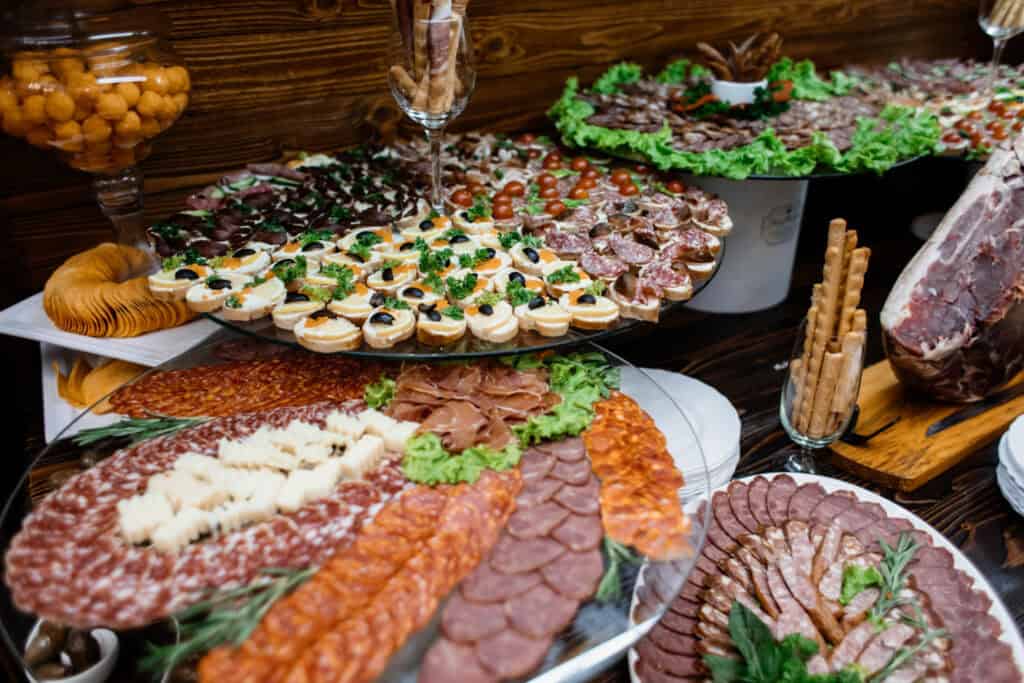
By Jermaine Thomas February 19, 2025
Catering event is essential for crafting an unforgettable event experience. Regardless of whether it’s a wedding, a corporate event, a birthday celebration, or a gala dinner, the quality of the food and beverage service can determine the success of the event. Professional catering encompasses more than just providing tasty dishes; it requires careful planning, flawless execution, and effective management of food services. Whether you’re a budding caterer, an event organizer, or a person planning an event, understanding catering logistics can help in delivering a seamless experience.
Understanding the Basics of Event Catering
What is Event Catering?
The provision of food and beverage services during planned events is referred to as event catering. It includes everything from organizing the menu and preparing the food to cleaning up afterward. In addition to handling all facets of food service management, such as staffing, logistics, and dietary requirements, a competent catering service guarantees that guests are fed adequately.
Why Catering is Essential for Events
A well-executed catering service enhances the guest experience in several ways:
- It provides a structured dining experience that aligns with the event’s theme.
- It ensures timely food delivery and quality service.
- It accommodates diverse dietary preferences and restrictions.
- It allows hosts to focus on their guests without worrying about food preparation.
Successful event planning includes a well-thought-out catering strategy to ensure seamless service.

Step 1: Pre-Event Planning and Consultation
The foundation of a successful catering event lies in thorough planning. This stage includes understanding client requirements, setting a budget, and finalizing the menu.
1.1 Client Consultation and Event Details
The first step in the event catering process is gathering essential details about the event, including:
- Event Type – Is it a wedding, corporate function, birthday party, or private gathering?
- Guest Count – The number of attendees affects portion planning and staffing.
- Venue Selection – Whether it’s indoors or outdoors impacts catering logistics like kitchen setup and food transport.
- Theme and Preferences – Special themes or cultural requirements influence menu choices.
1.2 Setting a Budget
The cost of catering services differs based on the complexity of the menu, the ingredients used, and the type of service provided (buffet or plated). Clients ought to establish their budget early to ensure expectations are aligned.
1.3 Menu Planning and Customization
Once the event details are set, the next step is curating the menu. Professional catering services take dietary restrictions, allergies, and cuisine preferences into account. Common menu options include:
- Buffet Style – Ideal for large gatherings with a variety of food options.
- Plated Service – Offers a fine-dining experience with structured courses.
- Cocktail Service – Focuses on hors d’oeuvres and finger foods.
This stage also includes tastings where clients sample dishes before finalizing the menu.
Step 2: Catering Logistics and Preparation
Once the menu is confirmed, caterers shift focus to logistics. This phase includes sourcing ingredients, arranging equipment, and staffing for the event.
2.1 Procuring Ingredients and Supplies
Fresh and top-notch ingredients are crucial for an excellent dining experience. Food service management groups collaborate with suppliers to obtain fruits, meats, fish, and other necessary items. Prompt purchasing guarantees freshness and avoids last-minute problems.
2.2 Kitchen and Equipment Setup
If the venue lacks an on-site kitchen, caterers may need to bring portable cooking equipment, such as:
- Stoves and ovens
- Chafing dishes and warmers
- Refrigeration units for cold storage
Proper kitchen setup ensures smooth food preparation and temperature control.
2.3 Staffing and Roles
Catering teams typically include:
- Chefs and cooks – Responsible for food preparation.
- Servers – Ensure timely food service and guest assistance.
- Bartenders – Manage beverage stations and drink service.
- Logistics coordinators – Oversee food transport and venue setup.
Adequate staffing is key to executing professional catering smoothly.
Step 3: On-Site Execution and Service
The day of the event is when all planning comes to life. Catering logistics play a crucial role in ensuring everything runs seamlessly.
3.1 Transportation and Setup
Food and equipment should arrive on time and in suitable condition. Caterers utilize insulated carriers, refrigerated vehicles, and temperature-regulated containers to preserve food quality.
At the venue, the catering team sets up food stations, dining areas, and serving equipment based on the event layout.
3.2 Cooking and Final Touches
While some food is pre-prepared, certain dishes require on-site cooking for freshness. Chefs and kitchen staff handle last-minute garnishing, plating, and quality checks.
3.3 Food Service and Guest Experience
The food service approach depends on the event style:
- Buffet – Guests serve themselves from a variety of dishes.
- Plated Service – Servers bring pre-portioned meals to tables.
- Family Style – Large dishes are shared among guests at each table.
Proper coordination ensures guests are served efficiently without long wait times.
3.4 Beverage and Bar Management
Bartenders oversee drinks at alcohol-related events, guaranteeing appropriate service. All guests are served at beverage stations with non-alcoholic options like tea, coffee, and mocktails.
Step 4: Post-Event Cleanup and Breakdown
Once the event concludes, the catering team handles cleanup, waste disposal, and equipment packing.
4.1 Clearing Tables and Packing Leftovers
Caterers make sure that glasses, dishes, and utensils are cleared quickly. Numerous services provide choices for donations of extra food or leftover packing for the host.
4.2 Equipment Breakdown and Venue Cleanup
Portable equipment is dismantled, and trash is disposed of responsibly. Venues often have specific guidelines on waste segregation and recycling that caterers must follow.
4.3 Post-Event Feedback and Review
In order to evaluate what went well and pinpoint areas for improvement, caterers should follow up with the client. Obtaining comments from visitors gives insightful information for upcoming events.

Challenges and Solutions in Catering Events
Managing Unexpected Guest Counts
At times, more visitors than anticipated show up. Caterers can manage last-minute changes by having flexible amounts and backup ingredients.
Weather Challenges for Outdoor Events
For outdoor catering, sudden weather changes can disrupt service. Tents, portable heaters, and covered serving stations mitigate these risks.
Dietary Restrictions and Allergies
Caterers should clearly label food items and train staff to handle special dietary requests efficiently.
Maintaining Food Quality Over Long Durations
Food spoilage during extended events can be avoided with temperature-controlled storage and appropriate serving methods.
Final Thoughts
Executing a successful catering event requires detailed planning, efficient food service management, and excellent catering logistics. From initial consultations to the final cleanup, every step contributes to creating an enjoyable dining experience for guests.
Professional caterers guarantee that every event is seamless, unforgettable, and stress-free for hosts by perfecting the event catering process. Understanding these catering basics will enable you to execute your event flawlessly, regardless of the size of the gathering.